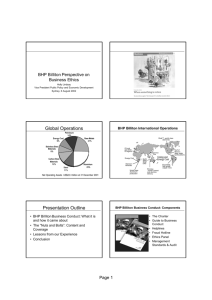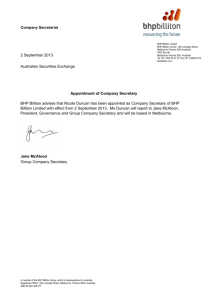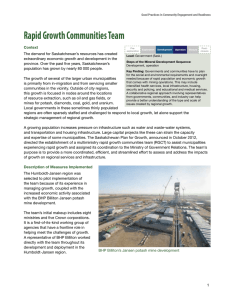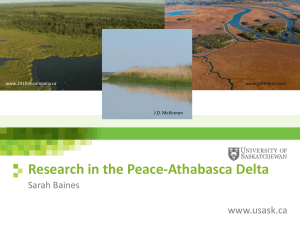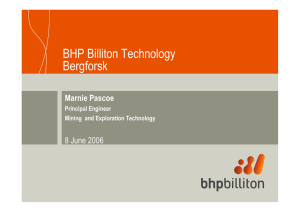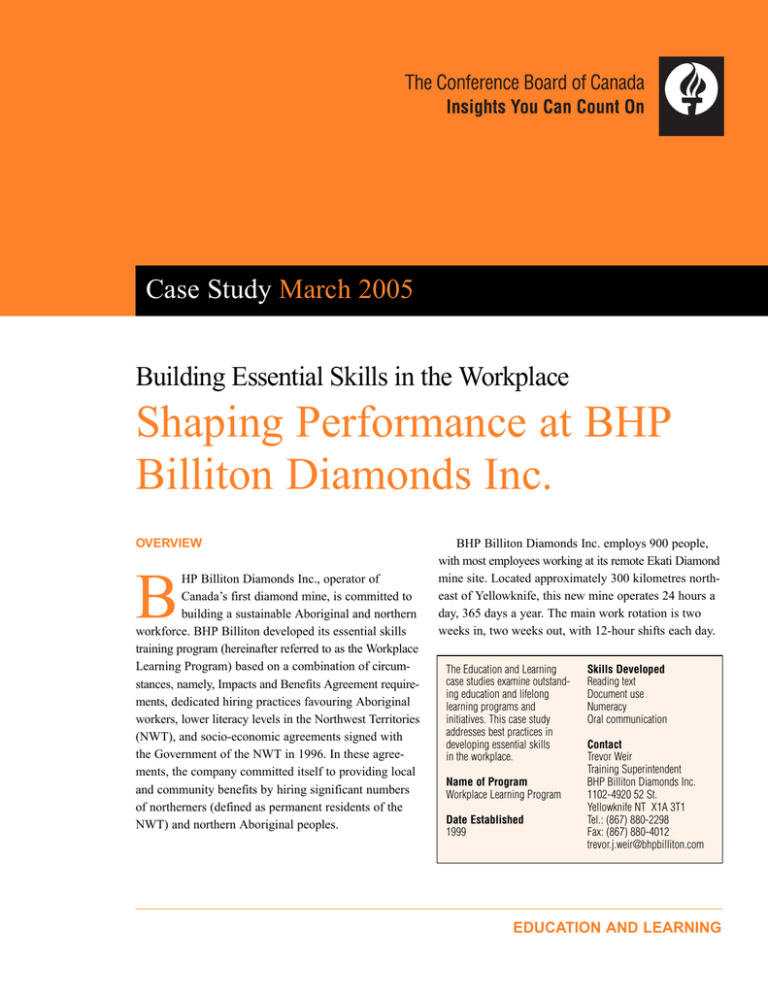
Case Study March 2005
Building Essential Skills in the Workplace
Shaping Performance at BHP
Billiton Diamonds Inc.
OVERVIEW
HP Billiton Diamonds Inc., operator of
Canada’s first diamond mine, is committed to
building a sustainable Aboriginal and northern
workforce. BHP Billiton developed its essential skills
training program (hereinafter referred to as the Workplace
Learning Program) based on a combination of circumstances, namely, Impacts and Benefits Agreement requirements, dedicated hiring practices favouring Aboriginal
workers, lower literacy levels in the Northwest Territories
(NWT), and socio-economic agreements signed with
the Government of the NWT in 1996. In these agreements, the company committed itself to providing local
and community benefits by hiring significant numbers
of northerners (defined as permanent residents of the
NWT) and northern Aboriginal peoples.
B
BHP Billiton Diamonds Inc. employs 900 people,
with most employees working at its remote Ekati Diamond
mine site. Located approximately 300 kilometres northeast of Yellowknife, this new mine operates 24 hours a
day, 365 days a year. The main work rotation is two
weeks in, two weeks out, with 12-hour shifts each day.
The Education and Learning
case studies examine outstanding education and lifelong
learning programs and
initiatives. This case study
addresses best practices in
developing essential skills
in the workplace.
Name of Program
Workplace Learning Program
Date Established
1999
Skills Developed
Reading text
Document use
Numeracy
Oral communication
Contact
Trevor Weir
Training Superintendent
BHP Billiton Diamonds Inc.
1102-4920 52 St.
Yellowknife NT X1A 3T1
Tel.: (867) 880-2298
Fax: (867) 880-4012
trevor.j.weir@bhpbilliton.com
EDUCATION AND LEARNING
Workers at the Ekati diamond mine site work a
12-hour shift for 14 days straight, followed by two
weeks off. When they are working their 14-day shift,
workers live on-site, spending all of their time in close
proximity to their co-workers. The only access to the
camp is by airplane.
The company gives hiring preference to Aboriginal
northerners and other NWT residents who have the
required skills. It sets a hiring target of 62 per cent for
northern residents and, within that target, 31 per cent
for northern Aboriginals.
The northern and Aboriginal labour force from
which the mine draws its workers presents several
skills-related challenges: a population with a strong
oral, rather than written, culture; workers with little
or negative experience with schooling; and, for many
of the workers, Ekati is their first formal workplace.
While incoming workers are “good with their hands”
and have good critical thinking and problem-solving
skills, academic skills (such as using numbers and documents) have often not been a priority for new recruits
and are frequently lacking. As a result, company management was aware that the literacy skills of the workforce
could be low. Newly hired workers’ skills and education
ranged from the level of beginning readers and writers
to high school graduation equivalency and apprenticeships. To address the need among some for literacy
skills upgrading, the company initiated a Workplace
Learning Program (WLP) once a full-time workforce
was in place at the new mine.
OBJECTIVES
BHP Billiton Diamonds established the WLP to
satisfy corporate production and safety needs, as well
as the learning goals of individual workers. The WLP
aims to:
• maintain and improve safety in the planning and
execution of all work activities; and
• offer upgrading to learners of all levels (through
literacy skills upgrading, pre-trades training and
apprenticeship preparation, instruction and support
for workers wishing to complete high school) and
access to correspondence courses.
2
The company addresses five essential skills, identified
as such by Human Resources and Skills Development
Canada (HRSDC). The company places a heavy emphasis
on document use, reading, writing, working with others
and oral communication. Because employees live and
work in close quarters at a remote site that does not
enable access to and egress from the site during their
two-week work terms, employees need to get along
with co-workers and supervisors, practicing good
communication and conflict resolution skills.
BHP Billiton considers the five essential skills
described above as “need to have.” It designates four
other skills—problem solving, critical thinking, numeracy
and computer use—as “nice to have.” Problem solving
and critical thinking are often embedded in reading and
writing exercises.
TARGET GROUPS
The company began its essential skills training by
putting on regular classes and structured programs. The
WLP is a resource for all workers who wish to upgrade
their skills, including BHP Billiton employees and contractors. Workers who benefit from the program range
from non-readers and non-writers to those wanting to
complete high school, enter a trade or successfully
complete their trades training, and they constitute the
program’s primary target audience.
Buoyed by the success of its core essential skills
program, BHP Billiton continued to canvass the skill
needs of its employees through surveys, informal feedback, and crew talks with workers, team leaders and
supervisors. These consultations resulted in the expansion of essential skills training from the original core
offerings to optional workshops targeting all workers.
Examples of optional workshops include money management (reading a pay stub) and starting a small business.
And an exciting new addition offered by the company
is an oral Dogrib language class.
As BHP Billiton enlarges its target group and learning
offerings, the company envisages offering its essential
skills programming at a “community level” within the
mine, reaching general mine employees as well as
temporary and permanent contractors through a kind
of learning centre.
The Conference Board of Canada
ACTIVITIES
The Workplace Learning Program at BHP Billiton
is built on an assessment of key jobs using HRSDC’s
essential skills job-profiling methodology.
At the Ekati mine site, this methodology was used
to profile the essential skills of four crucial jobs in 1999.
These jobs are Process Plant Operations Assistant,
Maintenance Helper, Heavy Equipment Operator, and
Warehouse Technician.
Use of this methodology involves identifying tasks
typically performed by workers in different roles and
collecting examples of documents used in the workplace. Generally, once tasks and documents have been
identified and collected, the skill requirements of different jobs are specified according to scales developed
for the Statistics Canada’s International Adult Literacy
Survey. The next step in assessing skill gaps is testing
the current skill levels of employees and new recruits.
BHP Billiton adult educators crafted a four-point
scale for rating essential skill levels based on the needs of
the workforce at Ekati. A skill level of 1 corresponded with
“easy”; a skill level of 4 corresponded with “difficult.”
The WLP develops skills through many learning
delivery methods and activities. After an assessment of
an individual’s workplace literacy skills, a customized
curriculum targeted at developing specific skills is
designed for that worker. Typically in module format,
the curriculum includes learning objectives, measure
mastery and completion, and use of authentic work
documents and resource materials.
WLP adult educators are responsible for designing
a relevant and useful curriculum. To that end, they
shadow workers in their jobs, on their equipment, and
in the field to see how and where literacy and essential
skills are used on the job (for example, document use
and logbook entries). Their diligence and “handson”
approach to curriculum design help the company and
the workers get what they need out of their investments
in learning.
The Conference Board of Canada
Mining Diamonds in the North
BHP Billiton uses a wide range of unique technologies to mine diamonds from the
permafrost near Yellowknife. The end product, cloudy white diamonds, emerges through
a complicated system of mining and refining techniques. First, cone-shaped kimberlite
pipes (large, characteristically shaped, rough-bearing diamonds) are extracted through
open pit mining or, increasingly, through underground mining techniques. Once rock
has been blasted and shovelled out, heavy equipment operators remove waste rock to
a dumpsite and haul kimberlite-bearing ore to a processing plant.
Next, kimberlite “scrubbers” separate kimberlite from surrounding granite, and a series
of increasingly refined processes gradually remove all remaining kimberlite from rough
diamonds. These secondary refining processes involve the use of centrifuges, “grease
tables” and X-ray luminescence.
Conveyor belts transport materials at increasing levels of refinement from hopper to
hopper as diamonds are carefully extracted from kimberlite.
The combination of mechanical, chemical and physical technologies requires operators
to use equipment optimally and to keep equipment in good working order to maximize
the diamond yield from mined kimberlite pipes.
Essential skills training is key to ensuring safety and productivity as diamonds are
extracted from the tundra.
The WLP at BHP Billiton has expanded in the
three-and-a-half years it has been operating. The company is moving from developing curriculum directly
aligned with workers’ jobs to optional modules broadly
related to workers’ interests and needs, such as money
management and small business management.
Adult educators at BHP Billiton strive to marry
essential skills with workplace content. Accordingly,
modules are labelled and positioned for workers based
on typical situations that require the use of essential
skills in and around the workplace. Thus, rather than
offering a general course on “document use,” instructors at Ekati have developed a “Standard Operating
Procedures (SOP)” module related to finding, reading,
understanding and interpreting SOPs at the mine site.
Another example is the way in which money management training has been pitched to employees. Rather
than offering a “money management” course, the Ekati
instructors have positioned their essential skills training
in this area as “Understanding Pay Stubs,” which involves
the development of the essential skills associated with
using numbers and documents.
At the mine, the WLP offers one-on-one tutoring,
in addition to small classes. And workers can always
take advantage of pre-trades math and science classes,
General Educational Development (GED) high school
equivalency preparation classes and computer reading
3
classes. Workers attend classes and other learning activities within the WLP for two hours every two to three
days. They attend the program on a combination of
work-release time and personal time.
While the breakdown of workers participating in
these different streams varies within BHP Billiton’s
WLP, typical enrollment patterns show that one-third
of participating workers are involved in core literacy,
another third are involved in independent learning and
GED preparation, and the remaining third are involved
in pre-apprenticeship training.
RESOURCES
After profiling the essential skills of its four entrylevel positions, BHP Billiton hired two adult educators
in 2001 to design and develop the WLP. Later on, as
demand for the program grew, it hired a third pre-trades
apprenticeship adult educator. Adult educators at Ekati
work split shifts and teach two classes per day. Approximately 60 per cent of their time is spent teaching content and providing one-on-one feedback to learners.
Instructors spend the remaining 40 per cent of their
time developing curriculum, scheduling classes and
working with other mine site team leaders, supervisors
and staff.
The Ekati mine site provides two classrooms for
essential skills training. One classroom is dedicated to
workplace training done on company time, while the
other, located in the mine’s recreational facility, is used
for voluntary learning activities, including GED preparation. In addition to providing classroom space, the
company provides customized literacy and trades materials and resources drawn from the Ekati mine site itself.
Essential skills training involves time commitments
from both BHP Billiton and from its workers. Employees
participating in core WLP programs receive paid work
release time. On average, this requires an investment on
the part of BHP Billiton of four to six hours per worker
during a typical two-week work rotation (in other words,
104 to 156 hours of paid release time per worker per year).
BHP Billiton’s investment in core essential skills
training is significant, given that approximately 140 of
the 900 shift workers at the Ekati mine site participate
in core training. In a given year, BHP Billiton invests
4
between 14,560 and 21,840 hours of paid release time
in core essential skills training. Core WLP programs
are voluntary—the company believes that a direct link
exists between success in essential skills training in
its core programs and safety, better productivity and
good morale.
Employees participating in independent study programs, including distance learning, do so on their own
time. Employees participating in GED preparation typically commit two hours weekly for eight months of their
own time, but are paid by the company for the nine hours
required to write the GED exams. BHP Billiton estimates
that 30 to 40 workers participate in such optional essential skills development programs at any given time.
Employees participating in trades training receive
three to four hours per week in paid work release time
to accomplish their learning objectives. Depending on
where they are in their pre-apprenticeship or trades
training program, workers may commit an equal
amount of their own time to training in these areas.
BHP Billiton does not receive any external funding for
its core and optional essential skills development programming. The company does, however, receive a small
portion of external funding for its pre-apprenticeship
and trades training programs.
BHP Billiton’s resource commitment goes beyond
providing release time for its employees to participate
in its WLP. The company makes a significant investment
in consulting with all staff to determine their needs and
in crafting customized programming to meet the skills
development needs of its entire workforce. Indeed, the
program is successful not only because BHP Billiton
commits so many resources to it, but also because it
invests in ongoing curriculum development: supervisors
are consulted often for curriculum ideas and feedback
on the company’s skills upgrading efforts.
INNOVATIONS
This program is unique in that it brings together
workplace learning, Aboriginal content and functional
literacy (which includes personal and community interests) and offers customized program content for each
individual learner. While the corporate need for a skilled
workforce is an essential consideration, the learning
The Conference Board of Canada
program focuses on the individual—both at the assessment stage and in the delivery of the program. To promote the continuity of individual learning programs, the
adult educators maintain close working relationships
with community adult educators across the NWT to
support workers’ learning on their time off from the
mine. The adult educators at the mine also participate
in collaborative training events with community adult
educators and college staff in order to be more effective
in the training they provide.
The program is designed in collaboration with
supervisors and with input from workers. The adult
educators have made a point of understanding workers’
positions as much as possible, through job shadowing,
learning how diamonds are mined, and by understanding everyone’s role in the process. The resident adult
educators work flexible shifts to accommodate day and
night shift workers. Workers may join ongoing literacy
classes and pre-trades upgrading offered at the mine,
and they receive paid work-release time to do so. To
help create and maintain an overall workforce with the
best skills possible, the WLP is open to BHP Billiton
employees and contractors alike.
Part of the “magic” of essential skills training at
the Ekati diamond mine site is the remoteness of the
location and the fact that employees live on-site for
two to three weeks at a time and have few options for
occupying themselves during their personal time. As
such, employees are a kind of “captive audience” who
have the opportunity to upgrade their essential skills
when they finish a shift. The Ekati site makes satellite
television available to all employees and does provide
recreational facilities, including saunas and golf simulators. Still, many employees voluntarily participate in
essential skills development activities on their own time
after their shifts are finished.
Another innovation in essential skills training at
Ekati is the emphasis placed on developing verbal communication skills and enhancing employees’ ability to
work with others. Because workers live and work in close
proximity for up to three weeks at a time—dining, working and sleeping in shared accommodation—managing
personal differences becomes an essential skill. Conflicts
from the workplace, the mess hall or living accommodations can easily spill over from one setting to another,
negatively affecting safety, productivity and morale.
The Conference Board of Canada
The Ekati workforce is also ethnically and religiously
diverse and incorporates workers of different ages and
genders who may be removed from their normal “support systems” when they are on-site at the mine. BHP
Billiton has a “zero tolerance” policy with regard to
violence and fighting in the workplace, and contract
workers teach courses at the site in non-violence crisis
intervention.
BHP Billiton takes a variety of approaches to
improving communication and teamwork skills in its
workforce. At the start of each day, it holds crew talks
as an opportunity for giving and receiving feedback,
uses case studies and employs role-playing techniques.
A typical essential skill that the company develops is
how to respond to feedback without becoming defensive. It also offers a course in radio etiquette, which
focuses on teaching radio operators to use the communications tool respectfully and not as a vehicle for
dressing down a co-worker over the public airwaves.
Perhaps the most exciting innovation in essential
skills training at the Ekati site is the recent trend towards
engaging employees and supervisors alike to participate
and act as facilitators in optional programming, specifically designed to meet the needs and interests of the
workforce. One of the upshots of this facilitation is the
company’s plan to offer a course in spoken Dogrib.
CHALLENGES
Creating a learning culture within a workplace at a
remote northern location is challenging. Besides the lack
of physical access to formal educational institutions
due to geographic distance, several concerns are apparent in developing and maintaining the learning program.
PROGRAM DEVELOPMENT CHALLENGES
• getting buy-in from all levels of management and
from workers who may be coping with the stigma
of low literacy
• learning how literacy and essential skills are best
developed at the mine site
• helping the mining world see and understand the
essential skills embedded in lessons developed by
adult educators
• helping the mining world see the link between the
essential skills that are taught and how those skills
are transferable and useful on the job (for example,
enhancing a worker’s communication skills may help
5
•
•
•
to make that worker more comfortable speaking up
at a safety meeting, which, in turn, may improve
morale, productivity and safety at the mine)
trusting adult educators to understand the business
need for essential skills training and convert that
into something teachable with observable workplace benefits
scheduling time for learning when production and
work at the mine site is continuous, 24 hours per
day, seven days per week, 365 days per year
understanding that, in terms of priorities, workplace
learning must come second to safety and production
targets (workers are not released from their work for
training if their absence will jeopardize meeting minimum crew numbers for safety or production reasons)
PROGRAM MAINTENANCE CHALLENGES
• dealing with an interrupted work and learning
schedule (that is, workers are present at the mine
site for two weeks, then are off-site for two weeks)
• working in isolation—program educators at the
remote site cannot gain easy access to other educators for consultation, feedback and discussion
• maintaining confidentiality of learners’ progress
when workers, supervisors and adult educators are
always in close quarters at the remote site: living,
travelling, eating and working together
• progressing fast enough—workers at low literacy
levels often want to see quick results from their
efforts
• helping individuals to gradually take responsibility
for their own learning paths and choices
The most striking challenge faced by the adult educators at BHP Billiton also represents Ekati’s greatest
opportunity. As markets and companies become more
competitive, they tend to allocate resources to new
technologies and more highly skilled workers. The Ekati
mine has resources on-site, and that is why workers and
production facilities are there. Yet, as the educators at
Ekati observe, essential skills are the “invisible thread”
to more effective training, increased production, morale,
retention and innovation. The adult educators, as essential skills trainers at Ekati, have observed that workers
who feel valued and empowered to speak up or write
out their suggestions tend to present helpful problemsolving ideas. By the same token, employees with low
morale tend to feel that the company is not interested
in hearing their experience in the field and withdraw
accordingly.
6
LESSONS LEARNED
Educators at Ekati have learned many lessons about
adult learners themselves and about the craft of teaching
adults in four-and-a-half years of offering their WLP.
In particular, educators have learned not to assume that
a worker has a strong set of essential skills based on
how they present themselves or on how articulate they
might seem.
Moreover, the adult educators at Ekati are continuously learning how to develop learning materials for the
workplace that are based on essential skills at a time
when procedures and practices in the mining industry
are continuously changing. The Ekati site has gone
from open-pit mining to underground mining, which
has required the introduction of new procedures for
safety and heavy equipment.
Employees themselves are learning about different
ways of learning (multiple intelligences). Learners are
realizing the depth and extent of knowledge and experience they bring to the job (such as the ability to figure
things out on their own when they are out on the land)
and are becoming more interested in building not only
their job skills but also the essential skills they need to
be more successful in their personal lives. Employees
recognize that the mine is not going to be operating
forever and they will need to prepare for the day when
they need to make a fresh start in the labour market.
Increasingly, workers at the Ekati site are investing
more in their work roles and are taking greater ownership of their skills development.
SOLUTIONS/KEYS TO SUCCESS
Despite the considerable challenges of creating and
maintaining a learning program at a remote northern
mine site, the WLP at BHP Billiton Diamonds Inc.
continues to be a great success. One very important key
to success: upper management’s buy-in and support of
the WLP with paid work release time. The real breakthrough on this front came when the WLP was listed
on the daily lineup sheet, and “who gets to go to school”
was posted alongside work assignments for the day.
Another key was inviting managers, team leaders
and supervisors to see first-hand what adult educators/
essential skills trainers are doing. This helped to remove
the “mystique” surrounding the training. Moreover,
The Conference Board of Canada
inviting input and suggestions from workers and managers alike helps to keep the WLP current and relevant.
The concept and definition of learning has expanded
since the WLP was launched in 2001. Learning is no
longer confined to the “three Rs”; workplace-relevant
learning that appeals to workers and their managers now
includes such things as the ability to figure out bonuses
based on production and safety records, researching the
causes of fatigue, and distinguishing, in Stoic-like fashion,
between things over which one has control and those
that are beyond one’s power to change (especially with
regard to interpersonal dealings, company policies, etc.).
In addition to management support and worker
enthusiasm, several elements are key to the program’s
sustainability:
• Consistency, confidentiality and respect for workers,
managers and supervisors is maintained.
• Confidence is instilled in workers, motivating them
to gradually take risks.
• Educators are approachable and available to everyone.
• Educators consult and collaborate with adult educators at other remote mine sites and with local
community adult educators to share resources and
ideas, provide support and learning continuity, and
to bridge isolation.
OUTCOMES
Due to the enthusiastic support and hard work of all
levels of employees, the learning efforts at the BHP
Billiton Diamonds Inc. mine site yielded positive results.
The outcomes range from some workers, formerly nonreaders and non-writers, learning to read and write, to
other workers passing pre-trades examinations. Workers
at every level of skills upgrading are making strides
towards improving their own performance and productivity, thus benefiting the organization as well as themselves. Other specific outcomes of the learning program
include:
• workers improving literacy and numeracy skills;
• workers preparing to complete their high school
equivalency examinations;
• the first group of 18 participants passed their GED
high school exams in June 2004 and received diplomas;
• Aboriginal workers moving from entry-level jobs
into apprenticeships and receiving support from the
company to ensure that they will succeed throughout
their apprenticeship;
The Conference Board of Canada
•
•
•
workers improving their confidence and participating
more often in safety meetings and discussions about
equipment or processing;
workers using their skills at home, with children,
in money management issues, problem solving and
decision making, with band council meetings, etc.;
and
workers setting long-term goals as a result of
increased morale.
IMPACTS AND BENEFITS
The long-term impacts of this relatively new program
have yet to be fully realized. One unintended, but highly
positive, consequence of the WLP is the program’s tendency to provide a voice for workers and a resource
for them to have some of their concerns and questions
answered. While WLP adult educators are not counsellors, they refer workers to their Employee Family
Assistance Program (EFAP) when appropriate. WLP
adult educators/essential skills trainers therefore occupy
a safe, in-between place where workers can ask a question and receive information without jeopardizing team
relations. In turn, they receive the right information in a
learning context, which helps to reinforce the relevance
and usefulness of essential skills training to workers in
their working and personal lives.
Ekati’s WLP is visibly producing a number of other
benefits linked to upgraded skills, including:
• a safer and more productive workplace;
• lower turnover—when workers feel their needs
are being met through their job, the WLP and their
support systems (co-workers) at the mine site, they
tend to stay in their jobs;
• increased participation in all workplace activities;
• workers taking on new roles as mentors and peer
learning coaches;
• improved self-esteem of workers;
• increased motivation to learn, enhance skills and
develop a career progression plan;
• workers pursuing educational goals that they would
otherwise not be able to pursue because of their
two-week-on/two-week-off work schedule;
• workers who may have had limited educational
opportunities overcoming their fears of reading
and writing;
• increased awareness of the importance and transferability of education, both on the job and at home;
7
•
•
support towards achieving new goals in workers’
lives; and
continued hiring of northern Aboriginals from
remote communities.
For many workers, having a pre-trades adult educator
on-site at the mine means the difference between pursuing a trade or giving it up. Many workers come from
small communities that do not have a pre-trades college
program or an apprenticeship program representative. With
proper tutorials and general support from the pre-trades
adult educator at the mine site, however, more workers
are now able to succeed in the formal schooling component of their trades training programs.
8
USE AS A MODEL
The WLP at BHP Billiton Diamonds Inc. is wellsuited for northern or remote workplace sites, with its
flexible training schedule and customized curriculum.
It especially targets Aboriginal workers who may have
had limited experience with written language or formal
education. BHP Billiton is in contact with other companies operating workplace education programs,
including coal- and diamond-mining firms in British
Columbia and Saskatchewan, who regularly ask BHP
Billiton for advice, resources and support.
The Conference Board of Canada
About the Education and Learning Case Studies
The Education and Learning case studies examine outstanding education and learning programs and initiatives. The case studies provide
in-depth analysis of the methods used to develop, assess, implement and deliver education and lifelong learning in schools, colleges,
universities, workplaces and communities. They focus on goals, activities, resource requirements, achievements and outcomes, benefits,
innovations, and keys to success and challenges.
This case study addresses the theme of building essential skills in the workplace and is funded by Human Resources and Skills
Development Canada.
Acknowledgements
Our thanks to the people we interviewed and to others who provided comment, including: Trevor Weir, Training Superintendent;
Susan Devins, Adult Educator; Elke Heinemann, Adult Educator; and Dan Machnee, Pre-Trades Adult Educator.
Building Essential Skills in the Workplace Case Study Series: Shaping Performance at BHP Billiton Diamonds Inc.
by Alison Campbell and Kurtis Kitagawa
About The Conference Board of Canada
We are:
•
•
Publication 717-05 • $10
•
A not-for-profit Canadian organization
that takes a business-like approach to its
operations.
Objective and non-partisan. We do not
lobby for specific interests.
Funded exclusively through the fees we
charge for services to the private and
public sectors.
• Experts in running conferences but also at
conducting, publishing and disseminating
research, helping people network, developing individual leadership skills and building
organizational capacity.
• Specialists in economic trends, as well as
organizational performance and public
policy issues.
•
•
Not a government department or agency,
although we are often hired to provide
services for all levels of government.
Independent from, but affiliated with,
The Conference Board, Inc. of New York,
which serves nearly 2,000 companies in
60 nations and has offices in Brussels and
Hong Kong.
255 Smyth Road, Ottawa ON K1H 8M7 Canada
Tel. (613) 526-3280 • Fax (613) 526-4857 • Inquiries 1-866-711-2262
The Conference Board, Inc. 845 Third Avenue, New York, N.Y., 10022-6679 U.S.A. Tel. (212) 759-0900 • Fax (212) 980-7014 • www.conference-board.org
The Conference Board Europe Chaussée de La Hulpe 130, Box 11, B-1000 Brussels, Belgium Tel. +32 2 675 54 05 • Fax +32 2 675 03 95
The Conference Board Asia–Pacific 2802 Admiralty Centre, Tower 1, 18 Harcourt Road, Admiralty Hong Kong SAR Tel. +852 2511 1630 • Fax +852 2869 1403
©2005 The Conference Board of Canada*
Printed in Canada • All rights reserved
ISSN 1205-1675 • Agreement No. 40063028
*Incorporated as AERIC Inc.
For more information about this Case Study,
please contact us at the numbers listed above.
Case Studies summarize the key findings of Conference Board
research and outline the implications for member organizations.
www.conferenceboard.ca

